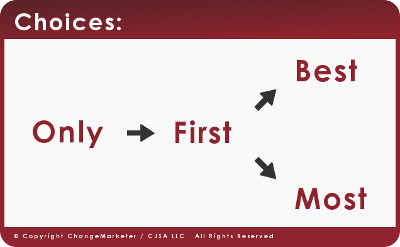Making Communications Roar so Growth Can Soar

Your potential customers have a lot of “noise” being directed their way by you, your competitors and industry sources (media, analysts, associations etc.) Clear positioning is essential to securing attention and gaining buying consideration. Let’s look at how the ChangeMarketer Positioning Choices Approach will make your communications roar and growth soar.
Recap
This is a thread about How to Leverage the Marketplace Forces that Matter Most for Business Growth. Eight crucial marketplace forces have been identified and are being explored in depth in this series.
Clear Positioning is Essential for Growth
In my practice as a ChangeMarketer, positioning issues typically get presented to me when the company is having problems gaining customer traction, is falling short of sales/growth goals or is experiencing frustrating communications with prospects, partners and/or media because the selling messages are so complex. In many cases, the root cause is the lack of clear positioning. In response, I have developed a three-step approach to help companies achieve clear positioning.
ChangeMarketer: Positioning Choices Approach
The key to effective positioning is to examine and merge together three perspectives — the company, competition and customer — before communicating with your target audience. Too often the company viewpoint is the first and only step taken before new products are launched, setting the stage for expensive communication overhauls as the competitive and customer perspectives are in inevitably encountered.
Get Started by Understanding the Choices
(Only, First, Best or Most)
While the number of words used to communicate company and product positioning are almost infinite, the core idea can be distilled into one of four powerful directions that should be given consideration and tested before the creative team is engaged.

These four choices are depicted in this way because a simultaneous claim of Best and Most is simply not credible with potential customers. Neither is claiming all four.
Only: Is a powerful idea that gets attention. People listen more closely expecting to hear something they have not heard before. Only is a positioning direction that emerging technology and patent-holding companies can claim.
First: Is a choice a “serial” innovator can claim. Pixar Animation Studios is an example. Their position is communicated clearly in the following description.

“Pixar’s climb to the pinnacle of computer animation success was a quick one, and the company continues to push the envelope in its art — and technology-inspired moviemaking endeavors.”
Best: Is often a specialty, luxury or niche player’s choice. Best is accompanied by an attribute description. BMW is an example with “German Engineering” as the attribute.

BMW’s most recent tagline “Sheer Driving Pleasure” communicates a promise of the “best” driving experience.
Most: Is a choice many growth companies can claim, with Amazon being a prime example. Amazon’s logo communicates this idea with the arrow going from “a” to “z”.

“Our vision is to be earth’s most customer centric company; to build a place where people can come to find and discover anything they might want to buy online.“
Step One: Take an Inventory
(Company, Competition, Customers)
Company Inventory
Form a working team from the company leadership (include sales, marketing, product, customer support and technology) and take an inventory of the existing positioning assets. Ask yourselves:
- What is that “only” we do?
- What have we done “first“?
- What are we the “best” at doing/offering?
- Where do we offer the “most” of something?
Don’t force any resolution at this stage. Make the list as long as it should be in order to cover your strengths. Be sure to include looking forward about what you are capable of becoming. Just make sure that each listed item is credible, believable to others. Then, refine the list into higher order concepts. An example might be “best approach” as a much shorter and clearer way to consolidate a long list of standout features. This gets you the “Company” perspective.
Competitive Inventory
Next, designate someone to create an inventory of your competitors’ positioning. The best information to gather is what is said on the bottom of their most recent press release under “About“, as companies keep these About descriptions more up-to-date than their website content. I also like to gather copy headlines, product names, Hoovers descriptions etc. that round-out the picture. Look at this information and compare it to your company list. Do you still standout? For example, if everyone has chosen best positioning, you will have to work harder to ensure that a difference exists or you will become lost in the “me too” noise. This gets you the “Competition” perspective while providing an opportunity to reflect on your “Company” perspective.
Customer Inventory
Next, designate someone impartial to conduct telephone interviews with a few of your best customers as well as lost customers. I like to start these interviews with a warm-up, yet telling question:
“In your own words, how would you describe what (Company Name) provides to someone unfamiliar with its products/services?”
This starts to get at the “Customer” perspective, and provides an opportunity to reflect on the “Company” and “Competitive” perspectives, while formulating positioning directions to test with a larger group of prospects.
Step Two: Test
With all three perspectives in mind, pick three directions positioning to test. Some examples include, Best Customer Service or Most Trusted Partner or Only End-to-End Solution. Two things to consider for optimal testing are:
- Participants: Positioning is better tested with people that have experienced the company and product.
- Include Messages: For each positioning direction, write and test 3-4 messages that are examples of how you would communicate the positioning. This will help the test participant give more granular feedback. For example:
- Positioning Direction: Best Customer Service
- Message Directions:
- The (Company Name) team is accessible, approachable and highly responsive to my requests.
- The skills and experience of the (Company Name) team enables them to understand what I need and how to resolve issues quickly and accurately.
I do my positioning and message testing as a web survey with ranked order responses. In the final analysis, the messages that rank high for appeal will be revealed. The most successful messages are difficult to predict, even for seasoned marketer, so there is simply no substitute for testing. The alternative is to waste time, resources and money.
Step Three: The Choice
Part of the reason clear positioning is often a later-stage choice is because of people’s tendency to want to be all things to all people. However, the time and expense of chasing every potential customer instead of understanding and focusing on the optimal customer has caused many growth windows to close. However, with the ChangeMarketer Positioning Choices Approach you can make your communications roar and your growth soar.
What is Next?
The 8 Marketplace Forces countdown continues. The next post will be…
Market Force #6: Are You Aligned with Customers Needs?
Many companies offer new technology as a tool sold on a standalone basis. However, customers often prefer bundled products and/or integrated services. Offering what the prospect will accept is key to growth.

